UVI Relayer 1.5 Review – A Must-Have Plug-In
Delay plug-ins have become very sophisticated but can be, well, a little too repetitive. Andy Jones catches up with UVI’s update to Relayer and discovers a plug-in that is more creative than many and one that does a bit more than delay… Details Manufacturer UVI Price €129 (€79 through to 29 May, 2017) Contact via […]

Delay plug-ins have become very sophisticated but can be, well, a little too repetitive. Andy Jones catches up with UVI’s update to Relayer and discovers a plug-in that is more creative than many and one that does a bit more than delay…


Details
Manufacturer UVI
Price €129 (€79 through to 29 May, 2017)
Contact via website
Web www.uvi.com
Requires
Mac OS X 10.7 or higher (32 and 64-bit)
Windows 7 or higher (32 and 64-bit), 300MB disc space
UVI is has come up with some pretty stunning effect plug-ins of late, and they look every bit as good as they sound. Someone at the company has clearly thought long and hard about the appeal and the aesthetic of its suite of effects and they include some joined up thinking in their easy to use and welcoming GUIs that is winning them a lot of fans.
My first meeting with this new UVI breed was with Thorus, a Polyphase Modulator plug-in – that’s a grown up modulator to you and I. It takes the concept of that type of effect – and I do love quoting myself – ‘up a few levels, and will aid creativity in many ways’. In a few issues’ time I’ll also look at UVI’s Rotary, a Leslie speaker emulator that pretty much does the same thing: takes a relatively simple effect idea, but injects it with enough 21st century design and programming functionality to make something that is as creative as it is practical. These plug-ins are almost instruments in their own right.
As I load up my Logic test project to check out the latest version of Relayer – that looks like it has the same philosophy – I realise I have both Thorus and Rotary across lots of tracks in the project. Have I become a UVI fan boy? That wasn’t always the case…
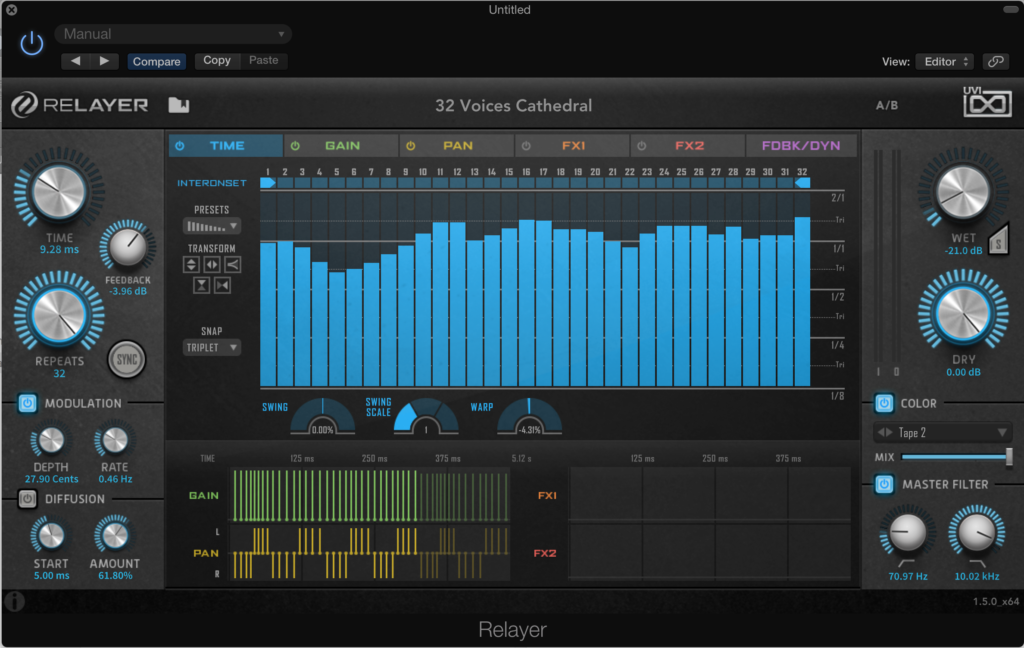
iLok unlocked…
It wasn’t UVI’s fault, more the iLok protection method that the company employed, or at least the way it was employed. I tried to test a library of theirs a few years back and it was impossible. Thankfully that has changed. iLok is still used but you get your serial number, download the plug-in and an iLok License Manager (software now supplied with every UVI plug-in) deals with the rest. You simply have to drag one of three usage rights to your computer to get it working, which is does straight away with Logic. My iLok bugbears have buggered off…
“These are great effects to twist and dial right away for instant gratification”
We’re off
Relayer is every bit as gorgeous as those other UVI plug-ins, and not just great looking but well thought out and easy to use. All the main features of a delay plug-in – Time, Repeats, Feedback, Mix, Wet and Dry – are on big and obvious dials. It’s a simple concept, maybe, but you’d be surprised how many GUI’s hide the obvious stuff.
Less big but still prominent are sections for Modulation, Diffusion and a Master Filter. Already we’re seeing that this is a vastly expanded delay plug-in – there is a lot more, and it’s not even hidden beneath the surface.
Relayer features a ‘Dynamic Patch Visualizer’ to give you a graphical representation of each preset and how the delay effect acts in time. If you have 16 repeats, for example, you can adjust each one’s gain, pan, time, feedback, and two effects simply by clicking and dragging your mouse across the 16 parts. There is also a set of Global tabs to adjust gain, reverse the pattern, or choose from preset patterns. It’s all very intuitive, all very easy and, as with Rotary, I was dialing and trying everything out, especially the modulation and filtering, before loading any of the supplied presets.
The Modulation effect on a simple level can act like a tape effect to offer a wow and flutter type process which works more obviously on short single delays. Indeed the Colour button on the right hand side of the screen introduces devices which you can add. They are found on a pull down menu and include Tape, Turntable and Radio modes among others.
The Filter section is also an obvious and dramatic way to change the sound and the Master Filter can be used to do anything from add subtle EQ and warmth right through to massive sweeps. A lovely feature is that high and low pass filters are also available in the Feedback tab so you can create some amazing differences in EQ or sweeps as the delay progresses.
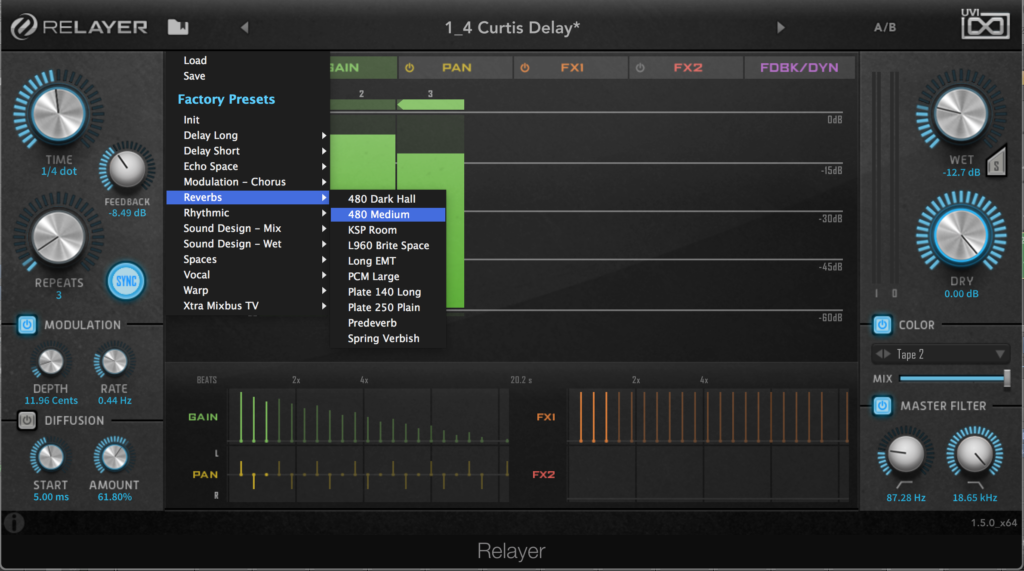
1. Presets – Delays, Mods, Reverbs, Vox and many more sections with approximately 170 in total (more added in v1.5).
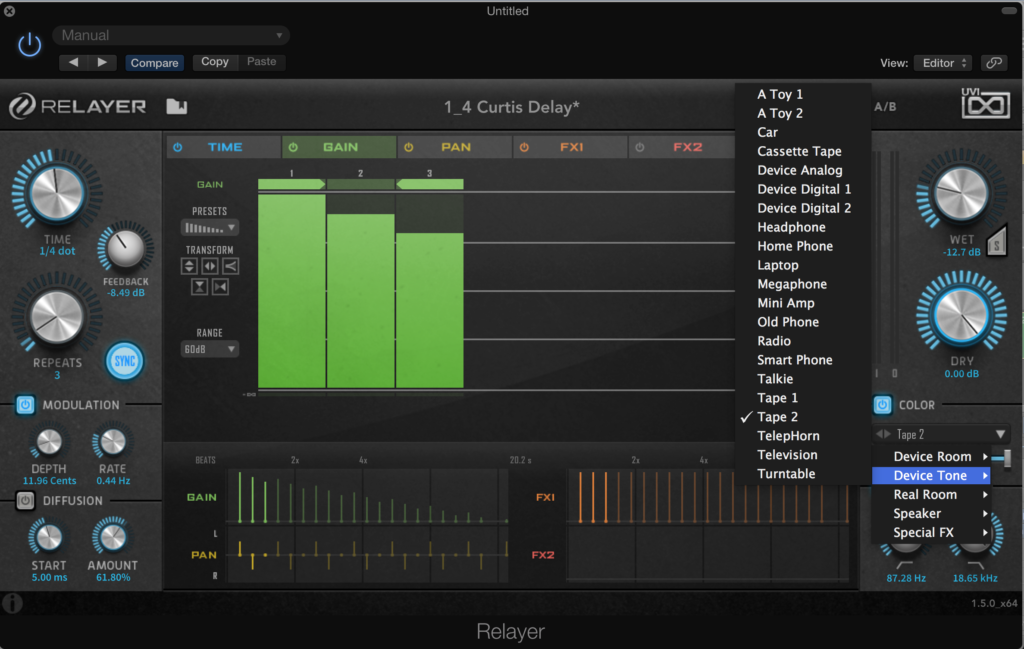
2. Colour – An overall effect to add the overall colour of a Device, Speaker, Tone, Room, or Special FX.
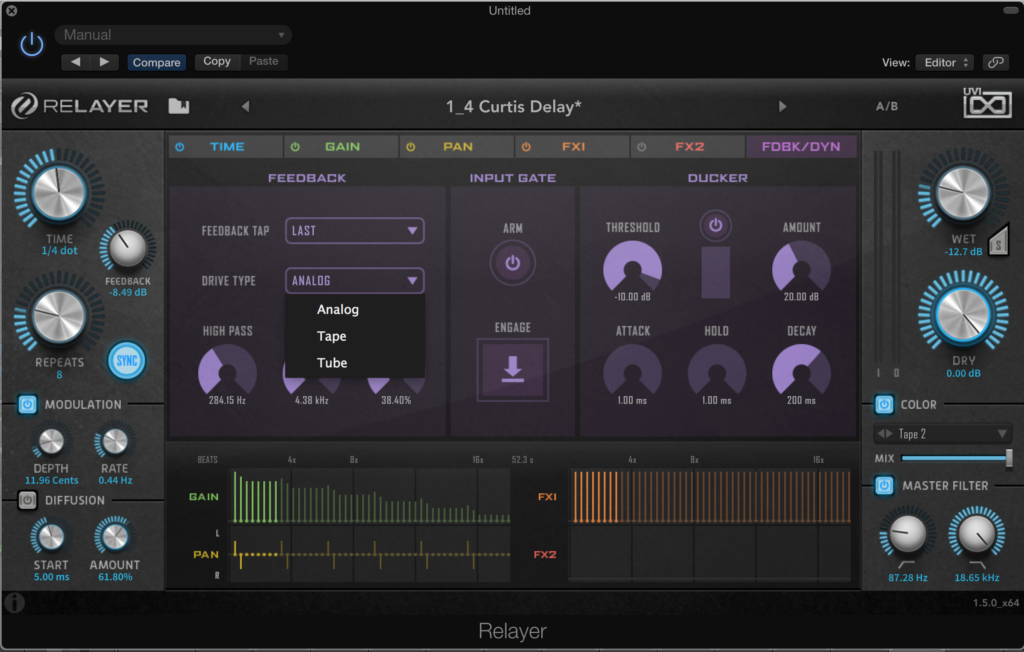
3. Feedback section – You can choose the delay to be fed back and even the type of feedback
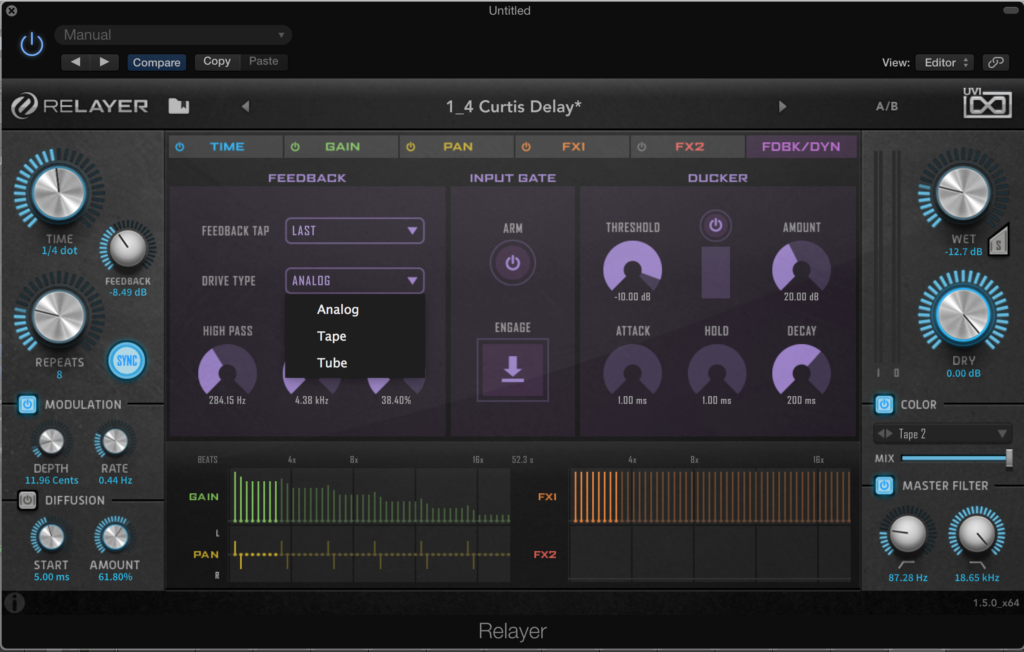
4. Ducker – The Ducker is also new for v1.5 of Relayer and offers loads of options of that famous pumping sidechain effect.
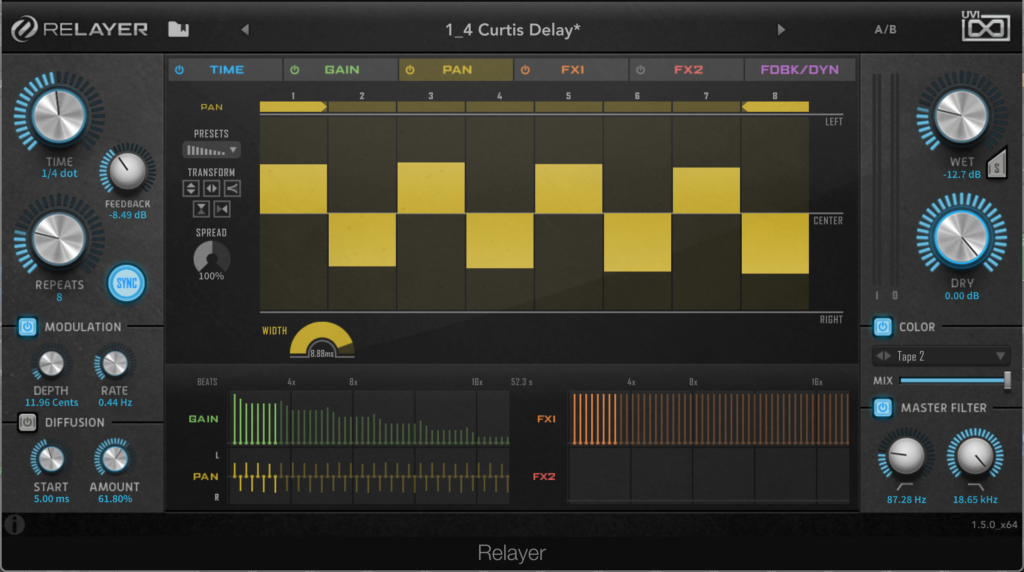
5. Pan Tab – Draw your pans in (they are alternately panned otherwise) on each note and choose width and spread.
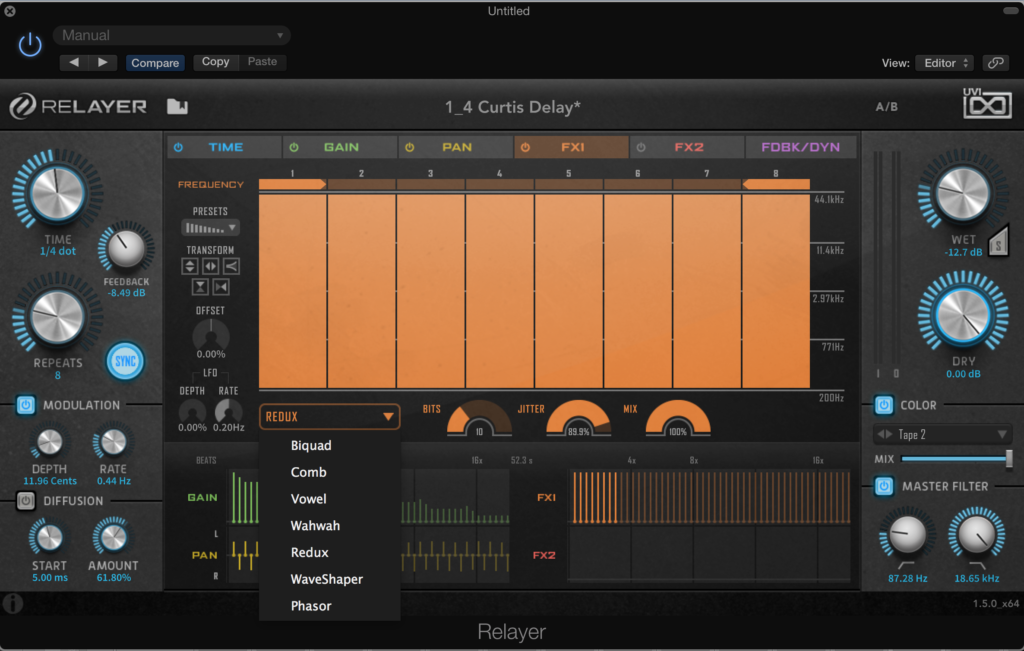
6. and more effects – Two more tabs in the main Patch Visualiser offer a set of seven added effects each, just in case…
Even more creative
Back to the Dynamic Patch Visualizer for even more creative options. I kept everything in sync with my song tempo just so it wouldn’t get too out of control but then threw myself in. On delay times, try reducing the snap so you can set the number of delays up in short bursts that perhaps open and close a set of repeats for some wild machine gun effects. You can even choose individual repeats to be fed back to create some unexpected action while the delay progresses.
As if you need more effects on Relayer, two tabs within the DPV allow you to choose from seven additional options. Some are more obvious in what they do than others (Wahwah, Comb and the new for v1.5 Phasor all offer some great sweeping and guitar effects); whereas Biquad offers subtle filtering; Waveshaper gives immense drive and distortion; Vowel delivers some sweeping vowel sound filtering; and finally Redux offers some bit mangling including an all new for v1.5 Mix parameter.
Pass the baton?
Initially worried that two pages was too long to talk about a delay I find myself at the end with options still to discuss – see above! There are a myriad of presets to do Relayer justice but you’ll be better off just diving in to discover the power. It really is capable of so much: glitch effects, reverbs, distortion, drive, modulation and filtering, all within a smart interface. Need just one plug-in to take to your desert island hard drive? This could well be it.
Alternatives
There are quite a few delay plug-ins out there– we say with some understatement. Waves’ H-Delay (www.waves.com) offers a great range of effects and is many a pro’s choice (currently on sale at $39 too). FXPansion’s Bloom (www.fxpansion.com) is almost the same money as Relayer (£79) and offers a similar range of effects. I’ve also always had a soft spot for the Ohm Force range of effects (www.ohmforce.com) with Ohmboyz being their dedicated delay although many of their others feature delays and all offer as much craziness as you could possibly ask for. Izotope’s DDLY Dynamic Delay (www.izotope.com) offers great value and is currently at £39 at Plug-in Boutique where you can find a huge selection of other delays.
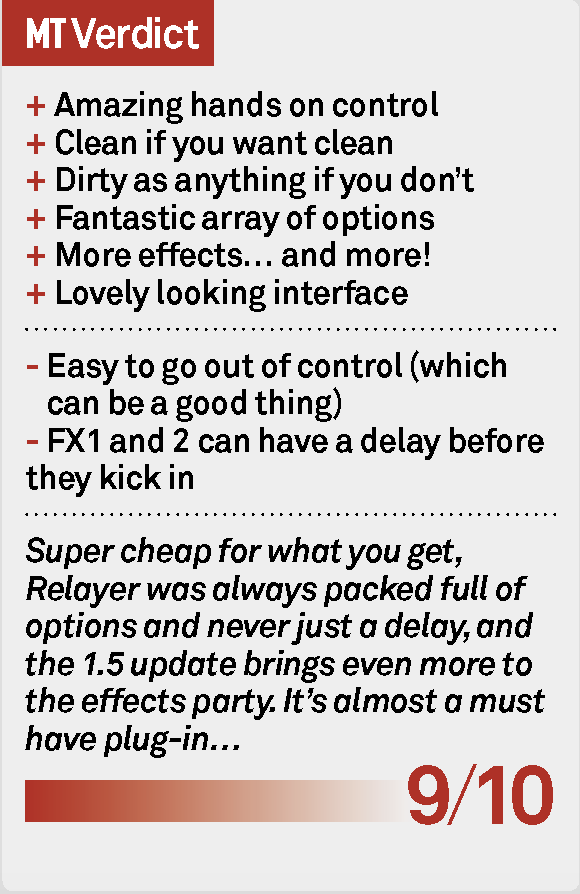
Key features
- AU, VST and AAX delay plug-in (and a bit more!)
- 100s of supplied presets; plus Colour options for rooms, devices and speakers
- 7 effects on 2 banks
- Dynamic Patch Visualiser for graphic editing
- NEW in v1.5: Diffusion helps turn your delay into a reverb; Ducker for pumping sidechain effects; Mix parameter within the Redux FX; and new Phasor effect; all new presets
